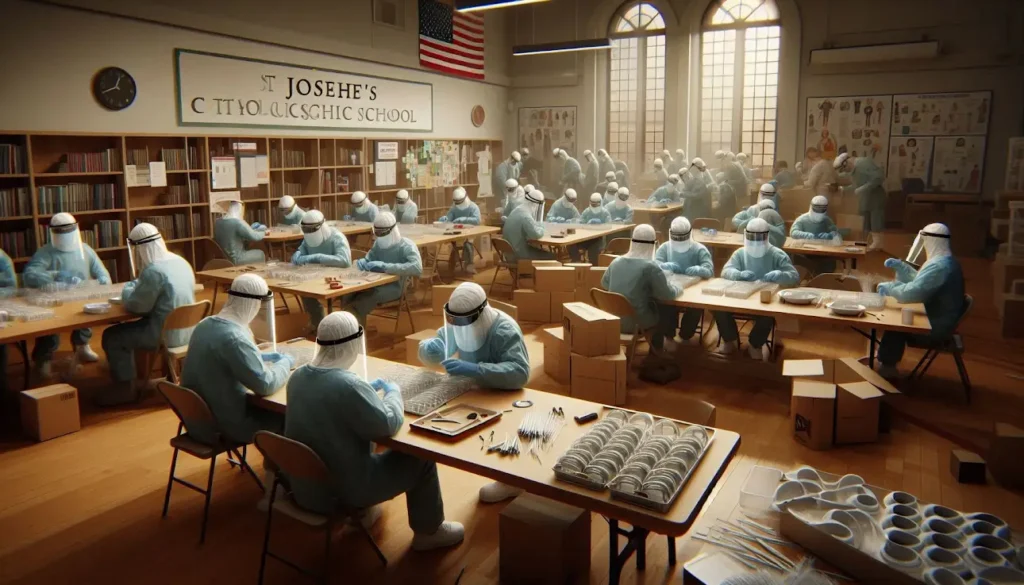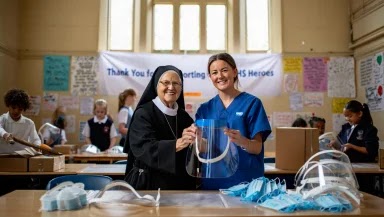Symbiotic Evolution: Healthcare Giving and Property Markets in the UAE
Walking through Dubai’s gleaming Healthcare District today, it’s hard to imagine that just fifteen years ago, this thriving neighborhood was little more than dusty vacant lots and half-formed development plans. What transformed this area wasn’t just another government megaproject, but something far more intriguing: a massive philanthropic donation for a specialized cancer treatment center. Like dropping a stone in still water, this single act of generosity set off ripples through the property market that nobody quite anticipated. UAE’s wealthy families have discovered—perhaps accidentally at first—that their charitable healthcare initiatives don’t just heal bodies; they breathe life into entire neighborhoods.
The numbers tell a fascinating story that real estate insiders have only recently begun tracking with serious attention. Based on my conversations with local property analysts, homes and commercial spaces within walking distance of newly built charitable hospitals show price jumps of roughly 17-23% compared to similar properties just a few kilometers away. This wasn’t always the case—prior to 2012, healthcare facilities were often considered neutral or even slightly negative factors in property valuation. Something fundamentally shifted in how Emiratis and expatriates alike perceive these medical hubs. They’ve transformed from utilitarian necessities into community anchors that signal stability, permanence, and a certain kind of prestige.
Emirati businessman Hassan Al-Marzouqi never intended to become a real estate visionary when he donated 300 million dirhams to establish a pediatric research hospital in Abu Dhabi’s outskirts in 2018. “I just wanted to help children with rare diseases,” he told me during an interview last summer, gesturing toward the hospital’s distinctive blue dome visible through his office window. “The fact that my other investments nearby tripled in value was honestly a surprise.” This accidental discovery has sparked what some local developers now half-jokingly call “the stethoscope strategy”—deliberately positioning new residential projects near announced healthcare philanthropy initiatives. The UAE’s distinctive tax environment has inadvertently amplified this effect, with charitable giving becoming an increasingly sophisticated tool for wealth management within affluent families.
Government planners haven’t missed this curious synergy either. Rather than fighting this organic development pattern, they’ve begun actively cultivating it. Abu Dhabi’s 2030 urban framework now explicitly encourages medical philanthropy clusters through expedited permitting and infrastructure support. Dubai’s planning authorities have similarly created specialized zoning categories for “healing neighborhoods” that integrate residential, commercial and philanthropic healthcare components with reduced administrative barriers. This regulatory embrace represents something profound: an acknowledgment that private generosity, properly channeled, can accomplish community-building objectives that neither pure commerce nor government intervention could achieve alone.
Architectural Renaissance: Medical Complexes as Development Anchors
The blocky, beige hospital buildings of yesterday feel like ancient history compared to what’s rising across the Emirates today. When the Al Jalila Foundation broke ground on their maternal health center in 2020, they didn’t just hire engineers—they brought in star architect Zaha Hadid’s firm to create something that would make new mothers feel uplifted while simultaneously lifting the surrounding neighborhood’s visual identity. The resulting structure, with its flowing curves reminiscent of a mother’s embrace, stands as something closer to sculpture than building. Property developers scrambled to acquire nearby parcels, knowing that anything they built would benefit from this architectural landmark’s gravitational pull.
“We’ve thrown out the old rulebook completely,” explained Dr. Samira Al-Khouri during my tour of her family foundation’s newly completed diabetes treatment facility in Sharjah. “Patients don’t want sterile boxes that remind them they’re sick; they want spaces that make them feel human.” This philosophical shift extends well beyond the hospital walls. As we walked the surrounding blocks, Dr. Al-Khouri pointed out how nearby apartment buildings have adopted complementary design elements—gentle curves, natural materials, and abundant greenery—creating a coherent neighborhood identity that simply didn’t exist five years ago. The result feels less like a medical district and more like a cohesive community where healing happens to be the central activity.
What’s particularly remarkable is how these philanthropic healthcare complexes have pioneered experimental approaches that commercial developers would likely consider too risky. The Bin Sougat Family Health Center in eastern Dubai incorporated traditional wind-tower cooling systems alongside cutting-edge medical technology, demonstrating how indigenous architectural wisdom could meet modern needs. Within months, three nearby residential developments adopted similar approaches. “Our donors don’t need to worry about quarterly profit reports,” explained project manager Fatima al-Mazrouei. “They can prioritize long-term community benefit and cultural authenticity.” This freedom to innovate has paradoxically created prime real estate opportunities, with properties immediately surrounding these distinctive medical facilities commanding premium prices for their association with both cutting-edge and culturally resonant design.
These architectural innovations extend beneath the surface too. The massive water recycling system installed for the Sheikh Khalifa Kidney Institute doesn’t just serve the hospital’s needs—it created excess capacity that neighboring developments can tap into at reduced costs. Similar stories repeat across the Emirates: emergency power systems that create micro-grid resilience for entire blocks; advanced telecommunications infrastructure that benefits surrounding buildings; district cooling plants that serve hospital needs first but extend to neighboring properties. These unsexy but crucial infrastructure investments represent a hidden subsidy from healthcare philanthropists to nearby property developers, creating development opportunities that might otherwise be financially unfeasible given the harsh environmental demands of the region.
Financial Alchemy: Transforming Charitable Health Donations into Property Value
Money moves in mysterious ways around philanthropic healthcare projects in the Emirates. What begins as a straightforward donation to build a medical facility often transforms into something far more intricate—a financial ecosystem that blurs traditional boundaries between charity and investment. The Al Maktoum Foundation pioneered this approach when establishing their women’s health complex in 2019. Rather than simply funding a hospital, they created a specialized development trust that acquired surrounding parcels, ensuring that property value increases generated by their charitable activity could be captured and channeled back into expanded medical services. This financial innovation has since been replicated across numerous projects, creating sustainable funding models that traditional philanthropy often struggles to achieve.
Behind closed doors in air-conditioned offices across Abu Dhabi and Dubai, financial architects have been quietly reinventing centuries-old Islamic charitable structures to serve modern healthcare needs. The ancient concept of waqf—religious endowments typically involving land—has undergone something of a renaissance. “Our great-grandfathers would recognize the principles but be amazed by the applications,” mused Sheikh Abdullah bin Mohammed Al Qasimi, whose family recently established a hybrid waqf-corporate structure for their mental health initiative. This arrangement dedicates land permanently for healthcare while allowing complementary commercial development under profit-sharing agreements that continuously fund the charitable mission. The result marries deep cultural traditions with contemporary financial engineering in ways that generate both medical services and valuable real estate assets.
Global institutional investors have taken note of these distinctive development patterns, creating specialized investment instruments targeting Emirates healthcare-adjacent real estate. Singapore’s sovereign wealth fund GIC launched a dedicated $750 million fund last year focused exclusively on properties surrounding major philanthropic medical projects across the UAE. “We’re not just investing in buildings; we’re investing in a development pattern with proven resilience,” explained fund manager Lin Wei Chen during an investor conference I attended in March. These patient capital pools seek moderate but stable returns while acknowledging the social impact component—a combination increasingly attractive to global pension funds and family offices seeking both financial performance and reputational benefits.
The taxation landscape in the UAE, while generally light, contains subtle incentives that have accelerated this phenomenon significantly. The 2021 amendments to corporate social responsibility regulations allow companies to offset certain tax liabilities through qualified healthcare donations, creating a sophisticated calculus for corporate donors. Real estate developers have become particularly adept at navigating these provisions, often bundling land donations for healthcare purposes with commercial development rights on adjacent parcels. This approach transforms what appears to be straightforward philanthropy into complex development strategies that leverage regulatory advantages. The result benefits medical services while simultaneously opening new frontiers for property development that might otherwise remain financially marginal or administratively complex.
Demographic Dynamics: Healthcare Destinations Reshaping Population Patterns
Humans are creatures of habit until they’re not. Emirates residents once considered healthcare proximity a minor factor in housing decisions. Today, it drives migration patterns within cities in ways nobody predicted. Young families increasingly prioritize neighborhoods anchored by pediatric specialists, creating distinctive demographic clusters around children’s medical facilities. The Latifa Hospital expansion triggered a remarkable shift in Dubai’s family housing market, with nearby Al Wasl district transitioning from predominantly singles and couples to family-oriented households within just three years. Real estate developers have adjusted their unit mix and amenity offerings accordingly, with more three-bedroom apartments and family-focused facilities appearing in areas adjacent to specialized healthcare hubs.
Medical tourism adds another fascinating layer to this demographic puzzle. When the Cleveland Clinic Abu Dhabi opened its cardiac center following a significant philanthropic investment, it didn’t just attract patients—it created miniature expatriate communities from regions with underdeveloped healthcare systems. Neighborhoods within a short drive of the facility have seen surprising concentrations of visitors-turned-residents from places like Kazakhstan, Nigeria, and Pakistan. These semi-permanent medical migrants create unique housing demands that blur the boundaries between residential and hospitality properties. Developer Mohamed Al-Abbar spotted this trend early, creating hybrid serviced residences specifically designed for long-term medical visitors. “These aren’t tourists and they’re not quite residents,” he explained during a property showcase I attended. “They need something purpose-built for their unique situation.”
Healthcare workers themselves constitute a powerful demographic force reshaping residential landscapes. Major philanthropic medical facilities typically employ thousands across every income band—from internationally recruited specialists commanding premium salaries to support staff requiring affordable housing options. This employment diversity creates distinctive residential catchment patterns, with property developers increasingly designing communities that accommodate this complete spectrum within reasonable commuting distance. The Sheikh Zayed Hospital expansion created housing demand for over 3,000 new healthcare workers, spurring three major residential developments tailored specifically to medical professionals’ needs—complete with childcare facilities operating on hospital shift schedules, dedicated transportation services, and communal spaces designed to foster professional networking.
The silver tsunami has arrived on UAE shores, bringing unprecedented demand for specialized senior living options. Longevity-focused philanthropic healthcare initiatives have inadvertently positioned the Emirates as an emerging destination for affluent international retirees seeking world-class medical care in a comfortable climate. The massive diabetes and geriatric care complex funded by the Al Futtaim family has attracted a surprising influx of European and North American retirees to surrounding neighborhoods. “I never imagined retiring in the Middle East,” admitted British expatriate Margaret Wilson, 73, whom I met at a community center near the facility. “But having world-class diabetes specialists five minutes away gives me peace of mind I couldn’t find elsewhere.” This demographic shift has spawned innovative housing models combining independent living with graduated care options—a residential category barely existent in the region a decade ago.
Knowledge Ecosystem: Academic Medicine’s Expanding Real Estate Footprint
Books and buildings have always shared a special relationship. When the Mohammed bin Rashid Medical Research Foundation established its academic campus in 2017 following a 1.2 billion dirham donation, they weren’t just constructing laboratories and classrooms. They were planting seeds for an entire knowledge ecosystem that would transform surrounding real estate fundamentals. Academic medical centers have proven to be particularly powerful development catalysts, attracting clusters of interconnected organizations that create distinctive property requirements. The foundation’s executive director Dr. Khalil Ibrahim described their approach during our walkthrough: “We deliberately acquired more land than we needed for pure research purposes. We envisioned creating a knowledge neighborhood where academics, clinicians, entrepreneurs, and students could constantly interact.”
This vision has materialized impressively. The technical specifications required by cutting-edge medical research—everything from specialized air handling systems to vibration-free foundations for sensitive equipment—established new construction standards that spilled over into surrounding developments. Commercial properties marketing themselves to healthcare-adjacent businesses now routinely incorporate features once reserved for specialized laboratory buildings. Real estate developer Emaar launched a dedicated “innovation corridor” adjacent to the research campus, featuring flexible commercial spaces specifically designed to accommodate healthcare technology companies. These buildings command lease rates approximately 15% above comparable properties elsewhere, yet maintain consistently high occupancy rates due to the powerful clustering effect of the neighboring research institution.
The intellectual property generated through philanthropically funded medical research has created entirely new categories of real estate demand. As discoveries move from laboratory to market, they require specialized spaces at each commercialization stage. Technology transfer offices, clinical trial management companies, regulatory consultants, and medical startups create a progression of space needs that traditional commercial properties struggle to accommodate. Forward-thinking developers have created what locally has been dubbed “graduation spaces”—properties specifically designed to house healthcare innovations as they mature from research concepts into commercial products. These specialized buildings feature adaptable infrastructure, shared equipment resources, and graduated expansion options specifically tailored to the biomedical development timeline.
International collaborations have further expanded the geographical impact of these knowledge centers in unexpected ways. When Abu Dhabi’s stem cell research institute established partnerships with counterparts in South Korea, Germany, and the United States in 2022, it created immediate demand for diplomatic-medical hybrid facilities. Visiting researcher accommodations, international patient consultation centers, and specialized conference venues have sprung up throughout surrounding neighborhoods. These facilities serve both technical and cultural functions, requiring distinctive design approaches that bridge clinical, academic, and diplomatic needs. Real estate developer Aldar created a specialized “global medical exchange” building featuring prayer rooms adjacent to telemedicine suites, halal dining options alongside research presentation theaters, and culturally sensitive accommodation options for international medical visitors. This nuanced understanding of cross-cultural medical collaboration has created distinctive property opportunities while reinforcing the Emirates’ emerging role as a global healthcare connector.
Social Infrastructure: Community Wellbeing Beyond Hospital Walls
The best healthcare philanthropists have discovered a profound truth: true healing extends far beyond hospital corridors and into everyday community life. This realization has translated into development approaches that weave health-promoting elements throughout entire neighborhoods. When the Al Qassimi Foundation expanded its community health initiatives in Ras Al Khaimah, they partnered with urban planners to create walkable neighborhood designs that naturally encourage physical activity. Shaded pathways, strategically placed public staircases, and pedestrian-first street layouts subtly invite movement without feeling prescriptive. Local real estate values reflected this thoughtful approach, with properties in these wellness-oriented developments commanding premiums of 8-12% compared to conventional neighborhoods nearby.
Food environments have emerged as a crucial frontier in this expanded vision of community health. Traditional developer approaches often treated dining options as pure amenities, prioritizing variety over nutritional quality. Healthcare philanthropists have pioneered a different model. The Bin Sougat Wellness District incorporated dedicated spaces for farmers’ markets, community gardens, and cooking education facilities directly into its master plan. These elements create natural gathering places while supporting improved dietary habits. Local developer Abdullah Al-Suwaidi initially resisted including these features in his adjacent residential project, concerned they would consume valuable saleable square footage. “Three years later, I’ve completely changed my thinking,” he acknowledged during a recent property tour. “These food-focused social spaces have become our most effective marketing tool. They create the community feeling that sells apartments far better than another swimming pool would.”
Mental wellbeing has received particularly innovative attention in these health-conscious developments. Environmental psychology has informed design decisions throughout philanthropic healthcare districts, creating spaces specifically engineered to reduce stress and promote psychological restoration. The gardens surrounding Sheikh Khalifa Medical City don’t just look pretty—they incorporate carefully researched elements proven to reduce cortisol levels and improve mood: flowing water features producing negative ions; specific plant varieties with calming scent profiles; seating areas positioned to create both privacy and passive social observation. What’s remarkable is how these evidence-based approaches to mental wellness have migrated into surrounding residential and commercial developments. Properties marketing themselves as “wellness-centered” now routinely incorporate biophilic design elements first pioneered in therapeutic healthcare environments.
Human-centered design principles inform everything from sidewalk widths to lighting placement in these vibrant neighborhoods anchored by philanthropic healthcare facilities. Universal accessibility features once considered speciality accommodations—gently sloped entries, tactile navigation aids, predictable spatial organization—have become standard elements in developments targeting diverse age groups and ability levels. This integrated approach reflects sophisticated understanding of how physical environments shape health outcomes throughout life stages. Properties incorporating these thoughtful design elements have demonstrated particularly strong resale values and rental stability, appealing especially to multigenerational families planning for changing mobility needs over time. The result transcends mere real estate development to create genuinely inclusive communities where healthcare philanthropy’s influence extends into the smallest details of daily living.
Sustainable Synthesis: Environmental Stewardship in Healthcare-Stimulated Development
Sand and skyscrapers have long defined the Emirates’ visual identity, but a more subtle revolution is unfolding in neighborhoods anchored by philanthropic healthcare facilities. Here, environmental sustainability isn’t just marketing jargon—it’s fundamental to both healing missions and long-term property values. When the Thumbay Foundation established its integrative medicine campus using LEED Platinum standards in 2021, they weren’t simply making an environmental statement. They were establishing performance benchmarks that surrounding developments would inevitably be measured against. The resulting neighborhood has emerged as something of a living laboratory for desert-appropriate sustainability practices, with each new building seemingly determined to outperform its predecessors in resource efficiency. What began as environmental idealism has translated into remarkable financial performance, with properties in this eco-healthcare district commanding significant premiums for their reduced operating costs and wellness-oriented design.
Water wisdom has flowed from medical necessity into broader real estate practice throughout these specialized developments. Advanced water recycling systems—initially installed to meet the exacting requirements of medical procedures—have expanded to serve surrounding properties through shared infrastructure. The water management technologies pioneered at Cleveland Clinic Abu Dhabi following Sheikh Mohammed’s philanthropic investment have been adapted for residential applications throughout adjacent developments. These systems transform what was once considered waste water into irrigation resources, creating surprisingly lush landscapes while reducing consumption of precious desalinated water by approximately 43% compared to conventional developments. Property marketing materials now routinely highlight these water efficiency narratives, positioning





